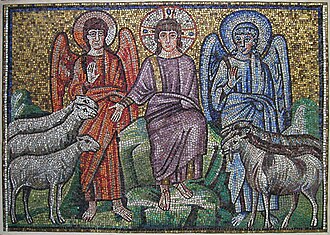
Back Paràbola de les ovelles i les cabres Catalan Vom Weltgericht German Parábola del juicio final Spanish Azken auziaren parabola Basque Les Brebis et les Boucs French משל הכבשים והעתודים HE Perumpamaan domba dan kambing ID Le pecore e i capri Italian 양과 염소의 비유 Korean ဆိတ်နှင့်သိုးများ Burmese
This article needs additional citations for verification. (November 2011) |

The Sheep and the Goats or "the Judgement of the Nations" is a pronouncement of Jesus recorded in chapter 25 of the Gospel of Matthew, through which Jesus strongly encourages his followers to take action to help those in need. [1] With this speech, Jesus indicates that, in order to go to Heaven, one must actively help people in need. Through it, Jesus explains that helping a person, whoever the person may be, is just the same as helping Jesus himself.[2]
According to Anglican theologian Charles Ellicott, "we commonly speak of the concluding portion of this chapter as the parable of the Sheep and the Goats, but it is obvious from its very beginning that it passes beyond the region of parable into that of divine realities, and that the sheep and goats form only a subordinate and parenthetic illustration".[3] This portion concludes the section of Matthew's Gospel known as the Olivet Discourse and immediately precedes Matthew's account of Jesus' passion and resurrection.[4]
This story and the parable of the ten virgins and the parable of the talents in the same chapter "have a common aim, as impressing on the disciples the necessity at once of watchfulness and of activity in good, but each has ... a very distinct scope of its own".[3]
- ^ https://www.bbc.co.uk/bitesize/guides/zgqjgdm/revision/5 BBC - The Sheep and the Goats
- ^ https://www.bbc.co.uk/bitesize/guides/zgqjgdm/revision/5 BBC - The Sheep and the Goats
- ^ a b "Matthew 25". Ellicott's Commentary for English Readers. biblehub.com. Retrieved 15 April 2018.
- ^ Jerusalem Bible sub-title for chapters 26–28
© MMXXIII Rich X Search. We shall prevail. All rights reserved. Rich X Search